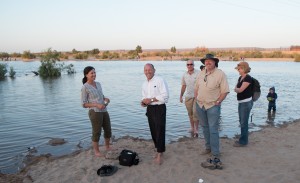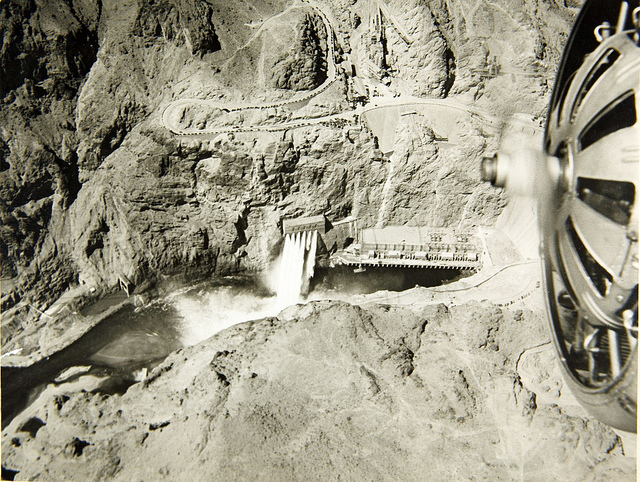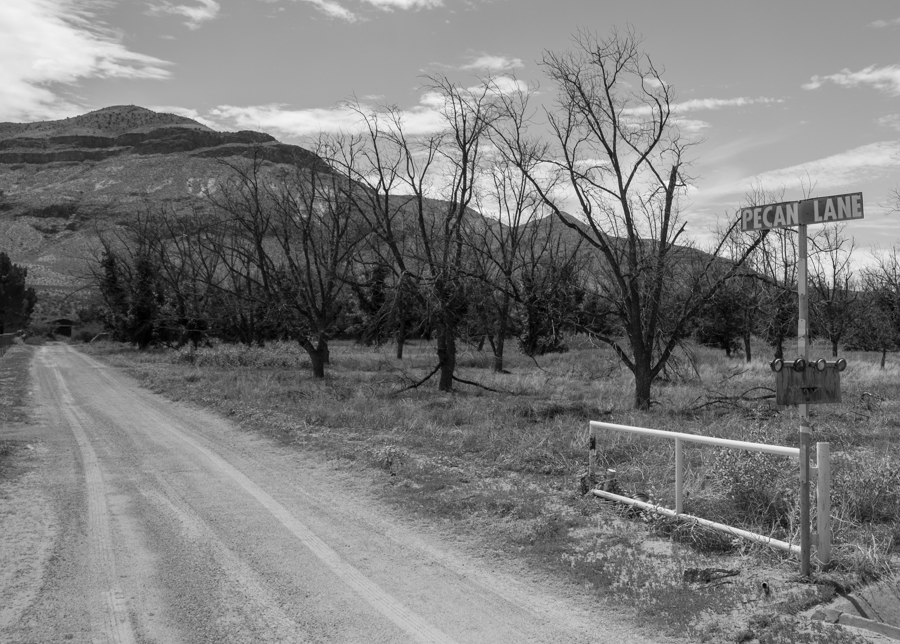California is finally about to join the rest of the West in regulating groundwater supplies. But the package of bills awaiting Gov. Jerry Brown’s signature is not an instant fix for the state’s shrinking, over-pumped aquifers.
It could be decades, experts say, before the most depleted groundwater basins recover under the legislation, which is a historic step in a state that long resisted managing a key water source.
The bills, which Brown is expected to sign, will take years to implement. And they create a weaker regulatory framework than is found elsewhere in the West.
“This is a much more laissez-faire approach and a much more light-hand-of-government approach than just about any other state,” said UCLA law professor Jonathan Zasloff.
Compromise on the Colorado
Assistant Secretary of the Interior Anne Castle, speaking late last month in Las Vegas:
With the crucial Lake Mead reservoir at 38 percent capacity and the Southwest in the grip of the driest 15-year period in more than a century, Castle said it will take multiple, incremental agreements to balance the water rights of cities, farmers, Indian tribes and states.
“Compromise is the only way we’re going to get ourselves out of this drought,” she said. “This is difficult state politics.”
Somebody should write a book about that or something. 🙂
More California groundwater discussion
Interesting comments from water people Scott Slater and Brian Jordan about the pitfalls ahead for California groundwater regulation:
Tim Quinn on California groundwater regulation
Tim Quinn of the Association of California Water Agencies (“big water” in Calif.) frames the state’s groundwater regulation legislation thus:
We recognize there are many serious concerns about the groundwater legislation in the Central Valley, where many drought-weary water managers feel hammered by surface water cutbacks and worry that the door is now open to a state takeover of groundwater. But this is not a state takeover. The fact is the legislation provides a significant and effective shield against state intervention, provided that local agencies develop and implement groundwater sustainability plans as provided in the legislation. That is a reasonable ask in our view, and the legislation provides tools and authorities some agencies have previously lacked to manage for sustainability.
For regulating California groundwater, this is only the beginning
California’s newly passed groundwater management legislation has rightly been called “the most significant set of water reforms to pass the Legislature since at least the Burns-Porter Act in 1960 that authorized the State Water Project”. In a state where overpumping is epidemic, regulation is incredibly important, as Jay Lund and Thomas Harter recently explained:
Sustaining a prosperous civilization in California’s dry climate requires firm accounting of all major water resources, including groundwater. When management of a resource as valuable as groundwater is lacking, overdraft and litigation fill the void. Investments that depend on groundwater then become riskier, leading water users to pursue more secure, but more expensive and environmentally damaging water supply sources such as deeper wells and new reservoirs. The added risk of unreliable groundwater also can increase the cost of credit for agriculture and rural development.
But it is important to remember that the notion that California groundwater is completely unregulated is a myth that misleads in important ways. California communities of interest in a water basin have long had the opportunity to come together to self-regulate their excessive pumping. Elinor Ostrom’s “Governing the Commons” explains how it was done in places like my old home, the San Gabriel Valley. Doing it, as Ostrom so helpfully documented, requires painstaking assembly of social and institutional capital in the form of shared understandings of the resources, institutions to measure and manage it, and agreements that in a basin that is being overpumped inevitably require some pumpers to pump less. This has proven both enormously successful in some places and enormously difficult in others.
As explained in this helpful overview by the folks at the Downey Brand law firm, the new legislation offers up some expanded and clarified legal authorities, and a carrot and stick approach (if y’all don’t get together and come up with your own community-driven groundwater management plan, the state will come in and impose one). But it still requires communities of interest to do the hard work described by Ostrom, work that they have up to now been unable or unwilling to do:
In many groundwater basins, it has been difficult to develop the political consensus needed to make hard choices about groundwater. After all, the members of local governing boards are often landowners or residents of their respective districts; the last thing that they want to do is to impose hardships on their friends and neighbors.
So yes, this is enormously important legislation. But it’s just the start of groundwater regulation in California, and success is not assured.
(h/t to Mavensnotebook, an invaluable piece of social capital/public good if ever there was one, for pointing me to the Downey Brand overview of the legislation)
Stuff I wrote elsewhere: RIP Yoda, the tree
When Henri Grissino-Mayer first told me about the tough little old Douglas fir named Yoda, it struck me as the perfect bit of anthropomorphic business for a book about tree rings for kids. When Henri emailed me last month to tell me that Yoda had died over the summer, I knew I couldn’t let the milestone pass without a memorial:
An icon for scientists studying the history of New Mexico’s climate, Yoda survived many a drought. But the tree couldn’t get through the latest one, said University of Tennessee professor Henri Grissino-Mayer.
Yoda was alive in March, according to Grant Harley of the University of Mississippi, one of a posse of researchers who have been tracking the tree. But when Harley brought a group of students to the remote site in August, the tree was dead.
“Bummer,” Harley wrote in an email sharing the news. “We had a moment of silence to pay our respects.”
Elinor Ostrom on mistrusting easy answers
The resource institutions that research has documented as working well in the field differ substantially in their detailed design but can usually be characterised as adaptive, multilevel governance systems related to complex, evolving resource systems. We need to overcome the tendency to recommend panaceas and encourage, instead, considerable experimentation at multiple levels to reduce the threats of massive collapses of valuable resources. (emphasis added)
Elinor Ostrom, Why do we need to protect institutional diversity?, European Political Science (2012) 11, 128–147
“Sharing Water: What an Environmental Experiment in Mexico can Teach us About the Future of the Colorado River”
I’m excited to be giving a talk on the Colorado River Delta environmental pulse flow Sept. 8 at Colorado College in Colorado Springs. If you’re in the neighborhood, please come by, say “hi”, and, if possible, ask questions when I explain things poorly. The talk is a snapshot of a work in progress, so no doubt a great deal of it will be explained poorly, because I’m still trying to figure it out myself.
The pulse flow last spring – a first-ever release of water down the desiccated Colorado River Delta’s main channel solely for environmental purposes – was a powerful symbol. For that reason alone, it was insanely cool, and it’s easy to explain and share the excitement. In a place where a river used to go to die, the Río Colorado came back to life. I’ll have pretty pictures of water flowing across a dry landscape.

A bunch of social capital standing in and around the water they helped put in the desiccated Colorado River channel near San Luis. March 27, 2014, John Fleck photo
But there’s something more obscure but also, I think, far more important that happened that’s proving much more difficult to articulate. At the risk of driving too fast and getting out in front of my headlights, I’m going to try to explain the nature and importance of the “social capital” that made this happen, and why I think the notion of social capital is critical to whether we succeed or fail in making a go of it as a society dependent on the increasingly scarce water of the Colorado River.
It’s illustrative of the problem that I have a hard time offering up a crisp definition of “social capital”, but here’s one I cribbed from someone else:
Social capital refers to the institutions, relationships, and norms that shape the quality and quantity of a society’s social interactions.
Some years ago, I heard a talk by former Bureau of Reclamation Commissioner Bob Johnson about his efforts to mediate water battles in the Apalachicola-Chattahoochee-Flint and Alabama-Coosa-Tallapoosa river basins in the southeastern United States. He was dispatched by his federal bosses to try to help with the problems because of his experience overseeing interstate water management in the Colorado River basin. Here’s how I described the problem:
The ACT and ACF basins have far more unallocated water to play with in sorting out the conflicts. “They’ve got 60 million acre feet of excess water,” he said. “On the Colorado River, we’ve got zero.”
But as a direct result of that lack of water on the Colorado, we’ve got a rich legal framework – the Law of the River – and accompanying personal and institutional relationships to go with it. “We have 80 years of fighting and working together,” Johnson said to the audience of Colorado River Basin water officials.
By comparison, in the wet climate of the southeast, water officials had few relationships with their colleagues in other states, and few institutional structures through which they could deal with problems when they arose, Johnson argued. In other words, they have plenty of water, but lack the tools they need to approach the problem of sharing. Because they’ve never had to think of it that way.
Their problem was a lack of social capital, not a lack of water. And, as Elinor Ostrom pointed out:
[S]ocial capital is hard to construct through external interventions.
Minute 319, the U.S.-Mexico agreement that made the pulse flow happen, provides a window into this “social capital” in action. It involves:
- institutions: U.S. and Mexican governments and the agencies within them, water management agencies on both sides of the border, environmental groups, research universities and end water users
- relationships: Individuals representing these institutions who know one another in a web that has, over time, become invested with a significant reservoir of trust, even as each is representing their own community’s interests as best they. These relationships embody a significant shared understanding of the Colorado River Basin’s problems and the range of solutions that might be possible, and who might suffer and/or benefit from those solutions.
- rules: A Byzantine array of compacts, treaties, laws and also more subtle norms that govern how all these institutions and people move water around the Colorado River system in a way that is intended to maximize some sort of ill-defined, constantly evolving utility.
All that combined in a deal that had something for everyone: money to upgrade Mexican irrigation infrastructure, water storage facilities for Mexico, conserved water for U.S. cities, an expanded understanding of the sharing of shortages for Mexico and the United States, and oh, by the way, a bit of water for the environment.
My shorthand for this, and the title of a seminar I’m giving Sept. 26 at UNM’s economics department, is “Solving the West’s water problems in a hotel bar”. The “hotel bar” thing is schtick, but has some substance behind it. The idea is people sitting around after a day of meetings wrestling with the problems, people who know one another’s desires, interests and needs, and saying, “Wait! What if we try doing it this way?”
The hotel bar stuff is very much necessary for dealing with Colorado River water problems going forward. But is it sufficient?
Testing Hoover Dam’s outflow jets
The San Diego Air And Space Museum posted some wonderful old aerial pictures of Hoover Dam on Flickr, and I’m hoping someone in the Inkstain posse can help me sort out the history. This image was taken by Colonel Orie W. Coyle, and appears to be a test of Hoover Dam’s outlet jets that I’m thinking must have been in the 1930s, as the then-Boulder Dam was first being filled:

Aerial View of Hoover Dam, Col. Coyle served with the Marines in WWI and worked for Douglas prior to his service in WWII, Col. Coyle served with the Marines in WWI and worked for Douglas prior to his service in WWII, courtesy SDASM
It must have been quite a spectacle. You can see the road lined with cars. The UNLV library has some similar pictures including this one, which is dated “1934-1936”. Anyone know the story?

